Are you fascinated by the diverse cultural tapestry of Vietnam and wondering what traditional clothes the ethnic groups in Tuyen Quang wear? SIXT.VN offers a unique window into this vibrant world. Discover the distinctive apparel of Tuyen Quang’s ethnic communities, offering a captivating peek into Vietnam’s rich cultural heritage. SIXT.VN is here to assist you in arranging an unforgettable trip to Vietnam, offering ease and access to the area’s cultural riches.
1. What Makes Traditional Clothing in Tuyen Quang Special?
Traditional clothing in Tuyen Quang serves as a vibrant marker of ethnic identity, reflecting the unique cultural heritage of each community. The traditional costumes of Tuyen Quang’s ethnic groups are distinguished by their elaborate designs, vibrant colors, and significant cultural meanings. These outfits, worn by groups such as the Tay, Dao, and Hmong, are more than simply apparel; they are a tangible representation of history, customs, and artistic abilities passed down through the ages. According to a study conducted by the Vietnam National Museum of Ethnology in 2018, traditional clothing in provinces such as Tuyen Quang not only represents cultural identity but also promotes social cohesiveness and continuity across generations.
2. Which Ethnic Groups Inhabit Tuyen Quang, and What Are Their Signature Styles?
Tuyen Quang is home to a mosaic of ethnic groups, each with its own distinct style of traditional clothing:
2.1 The Tay Ethnic Group
The Tay people, one of the major ethnic groups in Tuyen Quang, traditionally wear simple yet elegant indigo-dyed cotton clothing. Women’s attire typically includes a long dress or blouse paired with wide trousers, often accessorized with a headscarf and silver jewelry. Men wear similar indigo outfits, reflecting their connection to nature and agricultural lifestyle.
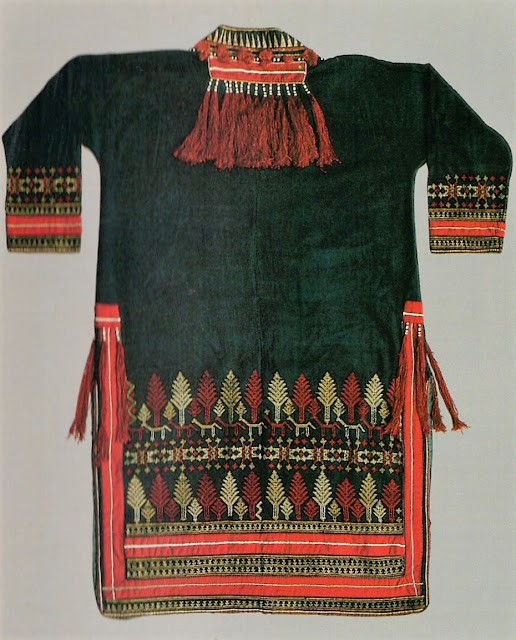 Tay women in traditional indigo clothing, reflecting their connection to nature
Tay women in traditional indigo clothing, reflecting their connection to nature
2.2 The Dao Ethnic Group
The Dao people are renowned for their elaborate and colorful clothing. Dao women often wear tunics with intricate embroidery, adorned with silver coins and vibrant tassels. The headwear is particularly distinctive, varying from turbans to elaborate red hats, signifying marital status and lineage. Men’s clothing is equally detailed, featuring embroidered jackets and trousers.
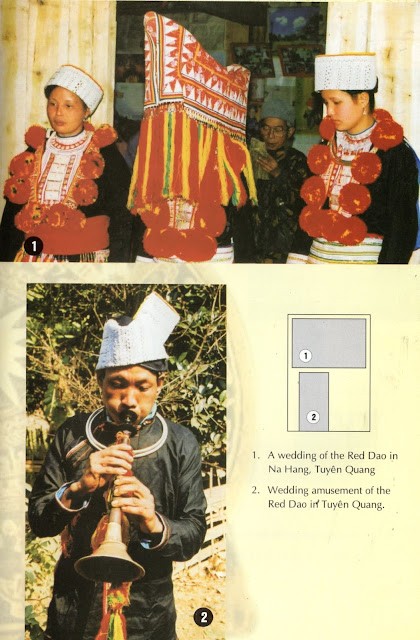 Dao women in vibrant traditional attire with intricate embroidery and elaborate headwear, reflecting their lineage
Dao women in vibrant traditional attire with intricate embroidery and elaborate headwear, reflecting their lineage
2.3 The Hmong Ethnic Group
Hmong attire is characterized by its vibrant colors and intricate batik patterns. Women wear pleated skirts, embroidered blouses, and leggings. Silver jewelry and elaborate headpieces complete the ensemble. Men’s clothing often includes embroidered jackets and loose trousers. According to research from the Vietnam Institute for Culture and Arts Studies in 2015, Hmong clothing reflects their history, beliefs, and artistic expression, serving as a crucial component of their cultural identity.
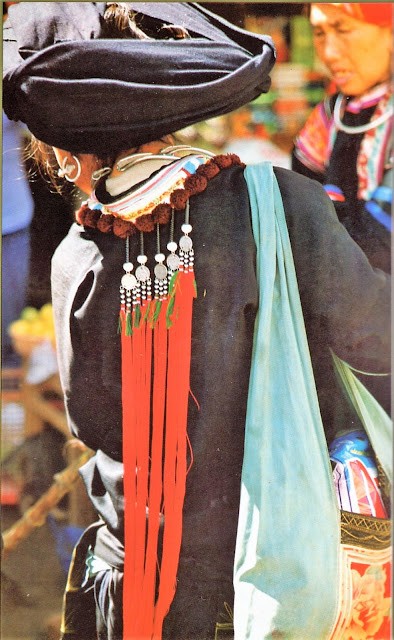 Hmong women displaying vibrant colors and intricate batik patterns on their traditional pleated skirts and blouses
Hmong women displaying vibrant colors and intricate batik patterns on their traditional pleated skirts and blouses
2.4 The Cao Lan Ethnic Group
The Cao Lan people in Tuyen Quang have maintained their distinctive cultural identity through their traditional attire. Cao Lan women typically wear indigo-dyed blouses and skirts, often embellished with colorful embroidery. They also wear headscarves and silver jewelry, which add to their traditional look. Men’s clothing is simpler, usually consisting of indigo-dyed shirts and pants.
2.5 The San Diu Ethnic Group
San Diu women often wear indigo-dyed clothing, including blouses and trousers, adorned with colorful embroidery. They are also known for their distinctive headwear, which can vary from simple headscarves to more elaborate turbans decorated with beads and silver ornaments. Men’s clothing typically consists of indigo-dyed shirts and trousers, with minimal embellishments.
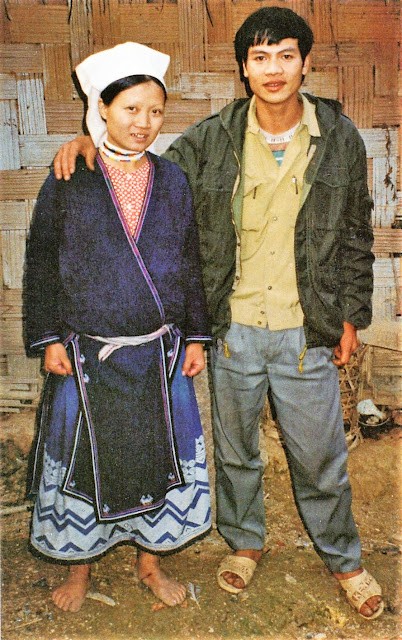 San Diu women's indigo-dyed clothing with colorful embroidery, adorned with beads and silver ornaments
San Diu women's indigo-dyed clothing with colorful embroidery, adorned with beads and silver ornaments
3. Why Is Traditional Clothing Important to These Communities?
Traditional clothing is an integral part of the cultural identity of ethnic communities in Tuyen Quang, embodying history, values, and artistic skills.
3.1 Preservation of Cultural Heritage
Traditional clothing preserves cultural heritage, reflecting historical events, customs, and beliefs. Each design, color, and embellishment tells a story, connecting people to their ancestors and preserving their unique identity.
3.2 Symbol of Identity
Clothing acts as a visual identifier, distinguishing different ethnic groups. This fosters pride and belonging among community members. The unique attire worn during festivals and ceremonies reinforces cultural bonds and strengthens social cohesion.
3.3 Economic and Artistic Value
Handmade clothing provides livelihoods and showcases artistic talent. Embroidery, weaving, and batik techniques passed down through generations demonstrate skill and ingenuity. Supporting local artisans through tourism helps preserve these traditions.
3.4 Ritual and Ceremonial Significance
Traditional clothing is essential for rituals and ceremonies, marking life stages and important events. Specific garments worn at weddings, funerals, and festivals hold deep symbolic meaning, reinforcing social structures and spiritual beliefs.
4. How Does the Dao Ethnic Group’s Clothing Reflect Their Cultural Identity in Tuyen Quang?
The Dao ethnic group’s clothing intricately reflects their cultural identity in Tuyen Quang through its elaborate designs, vibrant colors, and symbolic details.
4.1 Symbolic Embellishments
The Dao people use a variety of symbols and motifs in their clothing that have deep cultural meanings. Common motifs include images of dragons, phoenixes, and geometric patterns, each with distinct symbolism.
4.2 Distinctive Headdress
One of the most striking features of Dao traditional clothing is the headdress, which varies depending on the sub-group and marital status. Red turbans, adorned with silver coins and beads, are common among married women, while unmarried girls may wear simpler headscarves.
4.3 Silver Adornments
Silver plays a prominent role in Dao clothing, with silver coins, necklaces, and bracelets adorning outfits. Silver is believed to bring good luck and prosperity, and it also serves as a display of wealth and status.
4.4 Embroidery Techniques
Embroidery is a central element of Dao clothing, with intricate stitching and vibrant colors used to create elaborate designs. Different techniques, such as cross-stitch and satin stitch, are employed to add texture and depth to the garments.
4.5 Color Significance
Color holds significant meaning in Dao clothing, with red being a particularly important color. Red symbolizes good fortune, happiness, and vitality, and it is often used in wedding attire and festive clothing. Other colors, such as indigo and white, also have cultural significance and are used in various contexts.
5. Can You Describe the Significance of the Hmong People’s Batik Art in Tuyen Quang?
The batik art of the Hmong people in Tuyen Quang is significant for its cultural, historical, and artistic value.
5.1 Cultural Identity
Batik patterns are a visual language that conveys stories, beliefs, and social structures. Each design reflects the Hmong people’s history, environment, and worldview, strengthening their cultural identity.
5.2 Traditional Techniques
The batik-making process involves using beeswax to create intricate patterns on fabric before dyeing it with indigo. This method, passed down through generations, showcases the skill and ingenuity of Hmong artisans.
5.3 Symbolic Designs
Common motifs include spirals, geometric shapes, and representations of plants and animals. These designs symbolize concepts such as fertility, protection, and harmony with nature, reflecting the Hmong people’s values and beliefs.
5.4 Economic Empowerment
Batik provides economic opportunities for Hmong women, allowing them to earn income while preserving their cultural heritage. The sale of batik textiles supports families and strengthens community resilience.
5.5 Artistic Expression
Batik art allows Hmong artisans to express their creativity and individuality. Each piece is unique, reflecting the artisan’s personal touch and artistic vision. This art form fosters innovation and cultural exchange.
6. What Role Does Silver Jewelry Play in the Traditional Attire of Ethnic Groups in Tuyen Quang?
Silver jewelry plays a vital role in the traditional attire of ethnic groups in Tuyen Quang, serving as a symbol of wealth, status, and cultural identity.
6.1 Indicator of Wealth and Status
Silver jewelry represents prosperity and social standing within ethnic communities. The quantity and intricacy of the silver ornaments worn indicate the family’s wealth and prestige.
6.2 Cultural Identity
Specific designs and types of silver jewelry are unique to each ethnic group. These distinctive pieces help identify and differentiate the various communities in Tuyen Quang, reinforcing their cultural identity.
6.3 Amulets and Protection
Silver is believed to possess protective qualities, warding off evil spirits and ensuring good fortune. Many silver ornaments are worn as amulets, offering spiritual protection to the wearer.
6.4 Part of Rituals and Ceremonies
Silver jewelry is essential for important life events such as weddings, funerals, and festivals. Specific pieces are worn during these ceremonies to honor traditions and ancestors, reinforcing social bonds and spiritual beliefs.
6.5 Family Heirloom
High-quality silver jewelry is often passed down through generations, becoming cherished family heirlooms. These items carry historical and sentimental value, connecting current generations to their ancestors and preserving family stories.
7. How Do Traditional Costumes Vary Among Subgroups of the Dao People in Tuyen Quang?
Traditional costumes among subgroups of the Dao people in Tuyen Quang vary significantly, reflecting their unique histories, customs, and geographic locations.
7.1 Dao Do (Red Dao)
The Red Dao are known for their elaborate red headwear, which includes turbans and conical hats adorned with silver ornaments and tassels. Their clothing features intricate embroidery with vibrant colors, particularly red, symbolizing good fortune and vitality.
7.2 Dao Tien (Coin Dao)
The Coin Dao distinguish themselves with clothing adorned with numerous silver coins, representing wealth and prosperity. Women wear long tunics with embroidered panels and unique headdresses decorated with coins.
7.3 Dao Thanh Y (Blue Dress Dao)
The Blue Dress Dao primarily wear indigo-dyed clothing with minimal embellishments. Their outfits include simple tunics and trousers, reflecting a more subdued aesthetic compared to other Dao subgroups.
7.4 Dao Lo Gang
The Dao Lo Gang are recognized by their distinctive headwear, which resembles a padded roof. Their clothing features embroidered jackets and trousers, with limited silver ornamentation.
7.5 Dao Quan Chet
The Dao Quan Chet wear tight pants and floppy headdresses, setting them apart from other subgroups. Their clothing includes embroidered tunics and unique accessories, reflecting their distinct cultural identity.
8. What Are Some Common Materials and Techniques Used in Making Traditional Clothing in Tuyen Quang?
Traditional clothing in Tuyen Quang is crafted using various natural materials and time-honored techniques passed down through generations.
8.1 Natural Materials
Cotton is the primary material for making clothing due to its availability and durability. Linen and hemp are also used, particularly in more remote areas. Indigo dye is used for creating the characteristic blue hues of many traditional garments. Silk is used for special occasion clothing, such as wedding attire, adding a touch of luxury and elegance.
8.2 Dyeing Techniques
Indigo dyeing is a common practice, with artisans using natural indigo plants to create deep blue shades. Batik is a technique involving applying wax to fabric to create intricate patterns before dyeing. Tie-dye is used to create unique patterns and designs, with artisans binding and folding the fabric before dyeing.
8.3 Weaving and Embroidery Techniques
Hand-weaving is a fundamental skill, with artisans using looms to create fabric for clothing. Embroidery is a central decorative technique, with intricate stitching adding depth and texture to garments. Appliqué involves attaching fabric pieces to create decorative patterns on clothing, enhancing its visual appeal.
8.4 Silver Work
Silversmithing is a specialized craft, with artisans creating jewelry and ornaments to adorn clothing. Silver coins, necklaces, and bracelets are common embellishments, signifying wealth and status.
8.5 Traditional Tools
Looms are used for weaving fabric, with various types of looms catering to different weaving styles. Needles are used for embroidery and hand-sewing, requiring precision and skill. Wax application tools are used in batik, ensuring intricate patterns are created with accuracy.
9. How Can I Experience and Learn More About Traditional Clothing in Tuyen Quang?
Experiencing and learning about traditional clothing in Tuyen Quang can be an enriching cultural journey.
9.1 Visit Local Markets
Local markets in Tuyen Quang, such as the Tuyen Quang City Market and the markets in smaller towns and villages, offer a chance to see and purchase traditional clothing. These markets showcase a variety of textiles and garments made by local artisans, providing insights into their craftsmanship.
9.2 Attend Cultural Festivals
Cultural festivals in Tuyen Quang, such as the Long Tong Festival and the festivals of the Dao and Tay ethnic groups, often feature displays of traditional clothing. These events provide opportunities to see people wearing their traditional attire and learn about the cultural significance of the garments.
9.3 Visit Museums and Cultural Centers
Museums and cultural centers in Tuyen Quang showcase exhibits on the history, customs, and traditional clothing of local ethnic groups. The Tuyen Quang Museum and cultural centers in the region offer educational displays and information about the materials, techniques, and meanings behind the traditional attire.
9.4 Participate in Workshops and Craft Classes
Workshops and craft classes provide hands-on learning experiences with traditional textile techniques. These classes teach skills such as weaving, embroidery, and batik, allowing participants to create their own unique pieces and gain a deeper appreciation for the artistry involved.
9.5 Stay in Homestays
Homestays in ethnic villages provide immersive cultural experiences, including opportunities to learn about traditional clothing from local families. Staying in a homestay allows visitors to observe how traditional garments are made, worn, and maintained.
9.6 Support Local Artisans
Supporting local artisans by purchasing their products directly helps preserve traditional crafts and provides economic opportunities for communities. Buying traditional clothing and textiles ensures that these art forms continue to thrive and that the knowledge is passed on to future generations.
10. What Travel Services Does SIXT.VN Offer to Help Me Explore the Culture of Tuyen Quang?
SIXT.VN offers a range of travel services to enhance your cultural exploration of Tuyen Quang.
10.1 Tailored Itineraries
SIXT.VN designs custom itineraries to immerse you in Tuyen Quang’s cultural richness. These itineraries include visits to local markets, cultural festivals, museums, and ethnic villages, ensuring you experience the best of the region.
10.2 Airport Transfers
SIXT.VN provides seamless airport transfers for stress-free travel to and from Hanoi or other nearby airports. Reliable and comfortable transportation ensures a smooth start and end to your journey.
10.3 Hotel Bookings
SIXT.VN offers a selection of hotels and guesthouses in Tuyen Quang, catering to various preferences and budgets. Accommodations range from modern hotels in the city to charming homestays in rural villages, providing an authentic cultural experience.
10.4 Guided Tours
SIXT.VN arranges guided tours with knowledgeable local guides who offer insights into the history, customs, and traditions of Tuyen Quang’s ethnic groups. These tours provide deeper understanding and appreciation for the cultural heritage of the region.
10.5 Car Rental Services
SIXT.VN provides car rental services, allowing you to explore Tuyen Quang at your own pace. Having a private vehicle offers the freedom to visit remote villages, scenic spots, and cultural sites, enhancing your overall travel experience.
10.6 Cultural Immersion Activities
SIXT.VN organizes cultural immersion activities such as workshops, craft classes, and visits to local artisans, providing hands-on experiences and deeper connections with the community.
Ready to explore the traditional clothing and vibrant culture of Tuyen Quang? Let SIXT.VN help you create an unforgettable journey. Contact us today to book your airport transfer, secure your hotel, and plan your cultural immersion tour! Visit SIXT.VN or call +84 986 244 358 to start your adventure. Our address is 260 Cau Giay, Hanoi, Vietnam. Discover the beauty and cultural richness of Tuyen Quang with SIXT.VN.
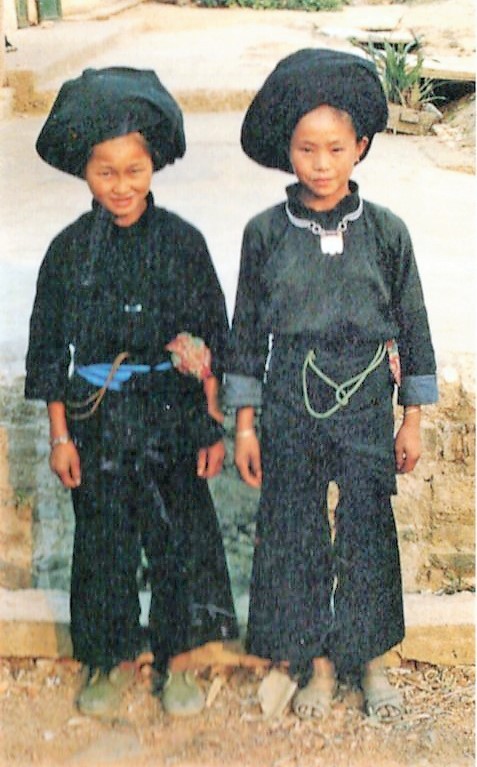 SIXT branded car ready for cultural exploration travel
SIXT branded car ready for cultural exploration travel
FAQ Section
Q1: What is the best time to visit Tuyen Quang to see traditional clothing?
The best time to visit Tuyen Quang to see traditional clothing is during cultural festivals, such as the Long Tong Festival (usually held in January or February) or ethnic holidays, as these events showcase vibrant traditional attire.
Q2: Are there any ethical considerations when photographing people in traditional clothing?
Yes, always ask for permission before photographing someone in their traditional clothing and be respectful of their culture and customs. Consider offering a small donation or purchasing local crafts as a gesture of appreciation.
Q3: Can I buy traditional clothing in Tuyen Quang?
Yes, you can buy traditional clothing in Tuyen Quang at local markets, craft shops, and directly from artisans in ethnic villages. Supporting these artisans helps preserve their cultural heritage and provides economic opportunities for their communities.
Q4: What are the main colors used in traditional clothing in Tuyen Quang?
The main colors used in traditional clothing in Tuyen Quang include indigo blue, red, white, and various shades of green and yellow, each holding symbolic meanings specific to different ethnic groups.
Q5: How can I learn to distinguish between the traditional clothing of different ethnic groups in Tuyen Quang?
You can learn to distinguish between the traditional clothing of different ethnic groups in Tuyen Quang by visiting museums, attending cultural festivals, and participating in guided tours led by local experts who can explain the unique characteristics of each group’s attire.
Q6: Are there any specific customs associated with wearing traditional clothing in Tuyen Quang?
Yes, there are specific customs associated with wearing traditional clothing, such as certain garments being reserved for special occasions or life events, and specific colors or patterns indicating marital status or social rank.
Q7: Can I participate in making traditional clothing in Tuyen Quang?
Yes, some ethnic villages offer workshops and craft classes where you can participate in making traditional clothing, learning techniques such as weaving, embroidery, and batik from local artisans.
Q8: How do traditional clothing designs reflect the environment and lifestyle of ethnic groups in Tuyen Quang?
Traditional clothing designs often incorporate natural motifs and patterns that reflect the environment and lifestyle of ethnic groups, such as images of plants, animals, and geometric shapes that symbolize their connection to nature and their agricultural practices.
Q9: What is the significance of headwear in traditional clothing of ethnic groups in Tuyen Quang?
Headwear holds significant cultural and symbolic value, often indicating marital status, social rank, or ethnic identity. Different groups wear unique headpieces, ranging from simple turbans to elaborate hats adorned with silver ornaments and tassels.
Q10: How can I ensure that my visit to Tuyen Quang is culturally sensitive and respectful?
To ensure a culturally sensitive and respectful visit, learn about local customs and traditions, ask for permission before taking photos, support local artisans by purchasing their products, and dress modestly when visiting religious sites or participating in cultural activities.



